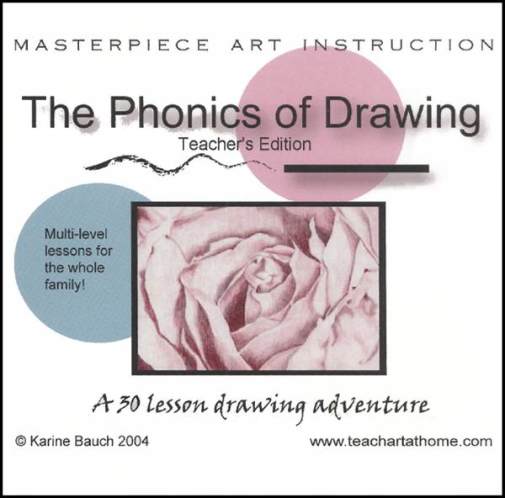We use cookies to make your experience better. To comply with the new e-Privacy directive, we need to ask for your consent to set the cookies. Learn more.
Phonics of Drawing CD-ROM
Everyone in your family will be able to benefit from these drawing lessons which approach the skill of drawing in bite-size, incremental steps. The CD-ROM contains 30 lessons, each resulting in the same basic project, but with slightly different directions for students in grades in the grammar stage (grades 1-4), the logic stage (grades 5-8), and the rhetoric stage (grades 9-12). In the grammar stage, the author expects that students will learn basic color theory, basic shapes and lines, basic shading and shadowing techniques, and the ability to imitate styles of classic artists. Objectives for the logic stage are similar as for the grammar stage, but with the expectation that the older student will develop more sophisticated skills and understanding in color theory, shading and shadowing. By the rhetoric stage, students should be learning composition, advanced color theory, advanced shading and shadowing techniques as well as developing their own individual style in their art. Although the lessons can be used for class, co-op, or home use, no artistic experience on the teacher's part is required. The author suggests that as the teacher, you will probably want to do the lesson yourself before class, and perhaps do it along with them during class. The lessons are designed to take about an hour to complete, and the author suggests a pace of one lesson per week. Lessons begin with drawing basic shapes and progress to include contour drawings; shading and shadowing; creating highlights; the color wheel; using monochromatic, complementary, and analogous colors in a drawing; shading with color, perspective, drawing in different styles, drawing portraits, creating a pleasing composition and more.
The lessons are very easy to use. They are accessible from the "lessons" tab at the top of the main screen, or you can jump into Lesson 1 after reading the basic information about the program. Each lesson consists of a teaching portion and a printable student handout for each. The lessons progress down the screen and include an objective for the lesson, the materials needed, and step-by-step instruction through the lesson. Each step is accompanied by an example of what the drawing should approximately resemble at that point, although depending on the skill level of the student, this will vary. The student handouts are typically a visual reference for the student for each lesson. Because the lessons are displayed on a computer, it would be hard for all students to see the subject they are drawing at the same time. Most of the student handouts will need to be printed in color, so you will probably need to have a color printer available to you. As far as supplies go, you will need to gather a few, but they are relatively inexpensive. Each student will need a set of 24 oil pastels, a set of 24 colored pencils, compressed charcoal, willow charcoal, a charcoal pencil, a white drawing pastel, a kneaded eraser, a blending stump, low-tack masking tape, tinted charcoal paper (9" x 12), white drawing paper (9" x 12"), newsprint paper (9" x 12"), and colored construction paper (9" x 12").
All in all, it's a great basic course that you can use with all of your children at the same time, without the older ones getting bored or the younger ones being frustrated. Everyone can take learn or refine their own skill while working through the lessons. Because the "models" are usually photos included in the lesson material, the students could apply the same techniques to photos of their own selection to expand the lessons or practice further. I think that the CD-ROM format is an interesting choice, but I can see how it is a practical way for everyone to be able to see the lesson without sharing a book, and the student handouts can all be printed which avoids the issue of having student packets or even having to reproduce pages for each student. A lot of concepts are covered here, taught mostly from example and the student's drawing experience. Because the lessons are so straightforward and foundational, I could see a definite advantage in revisiting at least some of them each year, as students grow older and more skillful. The folks at Practical Homeschooling are fans too - The Phonics of Drawing received the first-place award in their Interactive Learning Awards for art. System requirements (PC only) are: Windows 98 or higher, CD-ROM drive. Jess
| Product Format: | Other |
|---|---|
| Brand: | Masterpiece Art Instruction |
| Author: | Karine Bauch |
| Grades: | 1-AD |
| ISBN: | 9780980170801 |
| Length in Inches: | 5.5 |
| Width in Inches: | 5 |
| Height in Inches: | 0.5 |
| Weight in Pounds: | 0.1875 |

